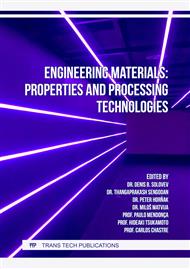[1]
Abir Saha, Santosh Kumar, & Avinash Kumar. (2021, January). Influence of pineapple leaf particulate on mechanical, thermal and biodegradation characteristics of pineapple leaf fber reinforced polymer composite. Journal of Polymer Research (2021) 28: 66.
DOI: 10.1007/s10965-021-02435-y
Google Scholar
[2]
Muhammad Yasir Khalid, Ramsha Imran, Zia Ullah Arif, Naveed Akram, Hassan Arshad, Ans Al Rashid & Fausto Pedro García Márquez. (2021, November). Developments in Chemical Treatments, Manufacturing Techniques and Potential Applications of Natural-Fibers-Based Biodegradable Composites. MDPI Journal Coatings, 293
DOI: 10.3390/coatings11030293
Google Scholar
[3]
Zaleha Mustafa, Anira Shahidah Razali, Siti Hajar Sheikh Md Fadzullah, Sivakumar Dharma lingam, Aslina Anjang, Qumrul Ahsan & Thanate Ratanawilai. Fabrication of Aligned Pineapple Leaf Fibre Reinforced Polylactic Acid Composite for High-Performance Bio composites. Malaysian Journal of Microscopy (2022), (Vol. 18 No. 1), Page 99-106.
DOI: 10.37934/arfmts.96.2.6573
Google Scholar
[4]
Ramengmawii Siakeng, Mohammad Jawaid, Mohammad Asim &Suchart Siengchin. Accelerated Weathering and Soil Burial Effect on Biodegradability, Colour and Texture of Coir/Pineapple Leaf Fibres/PLA Bio composites. MDPI Journal of Polymers, (2019). 458.
DOI: 10.3390/polym12020458
Google Scholar
[5]
R Siakeng, M Jawaid, H Ariffin & S M Sapuan. Thermal properties of coir and pineapple leaf fibre reinforced polylactic acid hybrid composites. IOP Conf. Series: Materials Science and Engineering. IOP Publishing, (2018), 368, 012019.
DOI: 10.1088/1757-899x/368/1/012019
Google Scholar
[6]
Siti Nur Rabiatutadawiah Ramli, Siti Hajar Sheikh Md. Fadzullah & Zaleha Mustafa. The Effect of Alkaline Treatment and Fibre Length On Pineapple Leaf Fibre Reinforced Poly Lactic Acid Bio composites. Journal Technology (Sciences & Engineering), (2017), 79:4–2, 111–115.
DOI: 10.11113/jt.v79.11293
Google Scholar
[7]
Sateeshkumar Kanakannavar and Jeyaraj Pitchaimani. Thermal buckling of braided flax woven polylactic acid composites. Journal of Reinforced Plastics and Composites, (2020). 0(0) 1–12.
DOI: 10.1177/0731684420957740
Google Scholar
[8]
Sateeshkumar Kanakannavar and Jeyaraj Pitchaimani & MR. Ramesh. Tribological behaviour of natural fibre 3D braided woven fabric reinforced PLA composites. Journal of Engineering Tribology, (2020), 1–12.
DOI: 10.1177/1350650120954949
Google Scholar
[9]
Supranee Kaewpirom & Cherdthawat Worrarat. Preparation and Properties of Pineapple Leaf Fibre Reinforced Poly (lactic acid) Green Composites. Fibres and Polymers, (2013), Vol.15, No.7, 1469-1477.
DOI: 10.1007/s12221-014-1469-0
Google Scholar
[10]
Ujendra Kumar Komal, Manish Kumar Lila & Inderdeep Singh. Processing of PLA/pineapple fibre based next. Materials and Manufacturing Processes, Taylor & Francis, (2021).
DOI: 10.1080/10426914.2021.1942904
Google Scholar
[11]
Zaleha Mustafa, Anira Shahidah Razali, Siti Hajar Sheikh Md Fadzullah, et al. Mechanical and biodegradation properties of biodegradable unidirectional pineapple leaf fibre/polylactic acid composites. AIP Conference Proceedings, (2022), 2496, 020007.
DOI: 10.37934/arfmts.96.2.6573
Google Scholar
[12]
A.T. Martins, Z. Aboura, W. Harizi, A. Laksimi, & K. Khellil. Analysis of the impact and compression after impact behaviour of tufted laminated composites. Composite Structures, Elsevier, (2017) 184, 352–36.
DOI: 10.1016/j.compstruct.2017.09.096
Google Scholar
[13]
Yasir Khaleel Kirmasha, Mohaiman J. Sharba, Zulkiflle Leman & Mohamed Thariq Hameed Sultan. Mechanical Performance of Unstitched and Silk Fiber-Stitched Woven Kenaf Fiber-Reinforced Epoxy Composites. MDPI Journal of Materials, (2020), 13, 4801.
DOI: 10.3390/ma13214801
Google Scholar
[14]
M. Rashid, J. L. Hanus, K. Chetehouna, K. Khellil, Z. Aboura & N. Gascoin. Investigation of the effect of tufts contribution on the in-plane mechanical properties of flax fibre reinforced green bio composite. Functional Composite Materials, (2021), 2:11.
DOI: 10.1186/s42252-021-00019-z
Google Scholar



